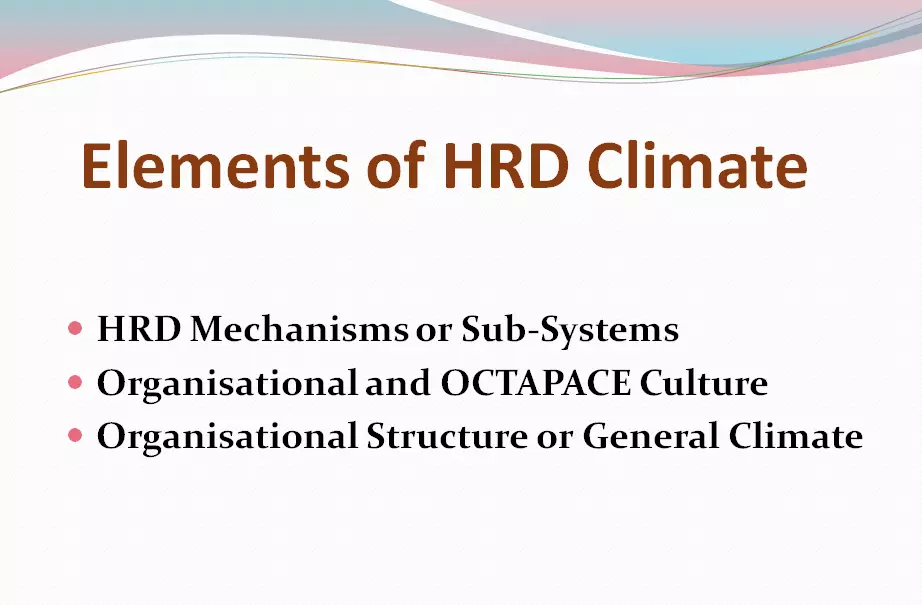Table of Contents:-
-
- What is HRD Climate
- The framework of HRD Climate in Organisation
- Elements of HRD Climate
- Factors Affecting HRD Climate
What is HRD Climate
HRD climate is the perception of the employees about the prevailing HRD culture in the organisation which is mostly brought out through surveys, covering the entire or a sample of employees. Mapping such a Human Resource Development (HRD) climate helps the organization understand the existing environment and enables them to take necessary steps to modify or change certain practices if there is a perceived gap between their desired state and the current situation.
An organisation becomes dynamic and growth-oriented if its people are dynamic and proactive. Through proper selection of people and by nurturing their dynamism and other competencies an organization can develop its people to be proactive and dynamic. To survive, an organisation needs to adapt to the change in the environment and continuously prepare their employees to meet the challenges; this will positively impact the organisation.
The HRD climate of an organisation plays a very important role in ensuring the competency, and motivational development of its employees. The HRD climate can be created using suitable HRD systems and top management leadership styles. HRD Climate is both a means to an end and an end. HRD climate is what employees have about the policies, procedures, practices, and conditions in their perceptions of the working environment. The HRD Climate survey instrument developed by T.V. Rao and E. Abraham has conceptualised HRD Climate under three dimensions of general climate, OCTAPAC culture implementation of HRD mechanisms.
According to Abraham, “HRD climate is a set of characteristics of an organisation which are referred in descriptions employees make of the policies, practices, and conditions which exist in the working environment”.
The framework of HRD Climate in Organisation
Organisational climate is viewed as an important tool for motivating and developing employees in any organisation. This concept has gained tremendous importance in recent times. Organisational climate is more of a descriptive nature and it depends on the perceptions and levels of satisfaction among the employees in an organisation within a given climate. In any organisation, employees’ expectations about having a work environment conducive to professional growth so, management and the workforce are responsible for developing the work environment.
Organisational policies, practices and conditions help create a developmental climate in an organisation. Thus, HRD climate is necessary to create such an environment in a workplace as HRD climate creates interest and motivation among employees for better performance and creates opportunities for growth and success. An optimal level of “developmental climate” is essential for facilitating Human Resource Development (HRD).
Managerial Responsibility for Employee Development
Such a developmental climate can be characterised as consisting of the following tendencies on the part of the organisation:
1) A perception that developing the employees’ competencies is the job of every manager/supervisor.
2) A tendency at all levels starting from top management to the lowest level to treat the people as the most important resource.
3) A tendency to be open in communication and discussion rather than being secretive (fairly free expression of feelings).
4) Faith in the capability of employees to change and acquire new competencies at any stage of life.
5) Making efforts to help employees to recognise their strengths and weaknesses through feedback.
6) Encouraging risk-taking and experimentation.
7) A general climate of trust.
8) A tendency on the part of employees to be generally helpful to each other and cooperate as well.
9) Team spirit.
10) Tendency to discourage stereotypes and favouritism.
11) Supportive HRD practices including performance appraisal, training, reward management, potential development, job rotation, and career planning.
12) Supportive personnel policies.
Organisations vary in the extent to which they have these tendencies. Some organisations may have some of these tendencies, some others may have only a few of these and a few may have most of these. It is possible to work out the profile of an organisation based on these tendencies. HRD climate contributes to the organisations’ overall health and self-renewing capabilities, which in turn increase the enabling capabilities of individuals, teams and the entire organisations.
Elements of HRD Climate
T.V. Rao developed an instrument to measure the HRD climate by assessing three components, which are as follows:
 Key elements that shape the effective HRD Climate are as follows:
Key elements that shape the effective HRD Climate are as follows:
- HRD Mechanisms or Sub-Systems
- Organisational and OCTAPACE Culture
- Organisational Structure or General Climate
1) HRD Mechanisms or Sub-Systems
Performance appraisal, training, feedback and counselling, potential appraisal, performance rewards, career planning, employee welfare, and job rotation are some of the HRD mechanisms.
2) Organisational and OCTAPACE Culture
Organisational culture is the pattern of beliefs, knowledge, attitudes, and customs that exist within an organisation. Organisational culture may result in part from senior management beliefs or the beliefs of employees. Organizational culture can be positive or negative, supportive or unsupportive. It can affect the willingness or ability of employees to adapt or perform well within the organisation.
The prevailing HRD culture of an organisation can be measured by analysing certain factors which bring out the way employees are handled and encouraged in the organisation. Thus, the culture about how the employees are encouraged to develop and take initiative is brought out through the following practices collectively called as OCTAPACE culture of an organisation, which is as follows:
i) Confrontation
It means the willingness to face and solve problems rather than to avoid them till they grow into a collective grievance. The willingness of executives to solve problems at the shop-floor level and to encourage workers to form Quality Circles and problem-solving groups are indicators of this value.
ii) Openness
It means the extent of willingness to share and receive information, ideas, and suggestions with the employees. The existence of an effective two-way communication system, house-organ, suggestion scheme, etc., is its indicator.
iii) Autonomy
It means the degree of freedom enjoyed by the workers. The existence of self-managed teams, quality circles, flexible working time, etc., are indicators of this value.
iv) Trust
It means the extent of faith which people have for one another. Loose or no supervision and the organisation’s trust in their employees’ words of self-certification indicate the presence of this value.
v) Authenticity
It means that people say what they mean and mean what they say. If the management preaches cost reduction and economy to its workers but practices extravagance or preaches the importance of quality but forces workers to meet quantity targets of sub-standard output, its preaching will have no effect because it lacks authenticity.
vi) Pro-Activity
It means the tendency to think ahead of the problem. An organisation’s plans and policies indicate this characteristic.
vii) Experimentation
It means the existence of a supporting environment to take risks and innovate. Whether management encourage its employees to bring in improvements by recognising their good ideas or do good ideas become victims of the “management by objections” system?
viii) Collaboration
It means people’s tendency to live and work together as cohesive groups. The existence of project organisation, team-building, common facilities like canteens and parking grounds, common uniforms for officers and workers, etc., are indicators of this value.
3) Organisational Structure or General Climate
An organisational structure is a snapshot of a work process and is frozen in time so that it can be viewed. The structure enables the people’s energy to be focused on process achievement and goal attainment. Employees must have a clear definition of not only the work structure but also the role used to organise the work. If the structure and the role are not clear, people will not know what the work process is, who is responsible for what, whom to go to for help and decisions, and who can assist in solving problems that may arise.
Factors Affecting HRD Climate
The following factors may be considered when evaluating the HRD climate:
1) Personnel Policies: These policies that show great concern for employees, emphasise equity and objectivity in appraisal policies that emphasise sufficient resource allocation for welfare and developmental activities, and policies that emphasise trust and a collaborative attitude among the people are important for creating a positive HRD climate.
2) Self-Renewal Mechanisms: Organisations that have built-in self-renewal mechanisms are likely to generate a positive HRD climate.
3) Commitment of Line Managers: The commitment of fine managers to the development of their subordinates is a very important determiner of the HRD climate. If line managers are willing to spend a part of their time with their subordinates, it is likely to have a positive impact.
4) HRD Instruments and Systems: Several HRD instruments have been found to generate a good HRD climate. Particularly open appraisal systems with emphasis on counselling, career development systems, informal training mechanisms, potential development, etc, contribute to the HRD climate.
5) Attitudes of Personnel and HRD Staff: A helpful and supportive attitude from HRD and personnel professionals plays a very critical role in generating the HRD climate. If the behaviour of any of these agents is not supportive, the HRD climate is likely to be negatively impacted.
6) Top Management Style and Philosophy: A developmental style of belief in the capability of people, a participative approach, openness and receptivity to suggestions from subordinates are some of the dimensions that contribute to creating a positive HRD climate.
FAQs
1. What are the elements of climate in HRD?
The elements of the HRD climate are the building blocks of an organization and can be grouped into three broad categories: OCTAPAC culture, HRD mechanisms and general climate.
The OCTAPAC culture focuses on the degree to which openness, trust, confrontation, autonomy, authenticity, proactiveness and collaboration are valued and encouraged to promote values of employee growth, development, and learning within an organization. The items concerning HRD mechanisms measure the seriousness of implementing these mechanisms to create a culture of continuous improvement. The items related to general climate refer to the importance attributed to human resources development by top management and line managers, providing a platform for employees to excel and contribute meaningfully.
2. What are the objectives of HRD climate?
The objectives of the HRD climate are to enhance the overall health and self-renewing capabilities of organizations, thereby increasing the enabling capabilities of individuals, dyads, teams, and the entire organization.
